Sandman
Books: Graphic Novel | Fantasy
Preludes and Nocturnes (1991), The Doll's House (1991), Dream Country (1991), Season Of Mists (1992), A Game Of You (1993), Fables And Reflections (1993), Brief Lives (1994), World's End (1994), The Kindly Ones (1996), The Wake (1997)
The Dream Hunters (1999) with Yoshitaka Amano, Endless Nights (2003)
We picked up the Sandman series because I love Neil Gaiman's writing. I'm not a big fan of comic books/graphic novels, but I hated knowing that he had writing out there I had not yet read. (Yes, I am that kind of reader.)
I decided that comics/graphic novels are mostly wasted on me. I barely look at the pictures but instead read through the text at my usual breakneck speed. I did try to look at the pictures, but then I got caught up in the story and was once again zooming through the text and ignoring the pictures.
Regarding the story, I absolutely loved it. The idea of trying to trap death and ending up with dream is one that I quite liked, although with my love of folklore and mythology, I suppose that is to be expected. I think what fascinates me as I consider it, is why he chose the seven "emotions/states" he chose to personify, besides the obvious fact that they all started with the letter D. Of course the same could be asked of Piers Anthony's Incarnations of Immortality, a series that had several books that I really liked, several I didn't care for, and then ended rather badly. What made him choose those incarnations? Mythology is littered with gods and goddesses of various forms and functions. Why limit yourself to seven? (And interestingly enough, both the Sandman and Incarnations of Immortality limited the main incarnations to seven.) I realize that it would be quite difficult to write about endless numbers of characters, but why seven?
Preludes and Nocturnes (1989) Neil Gaiman, Sam Kieth, Mike Dringenberg, Malcolm Jones III
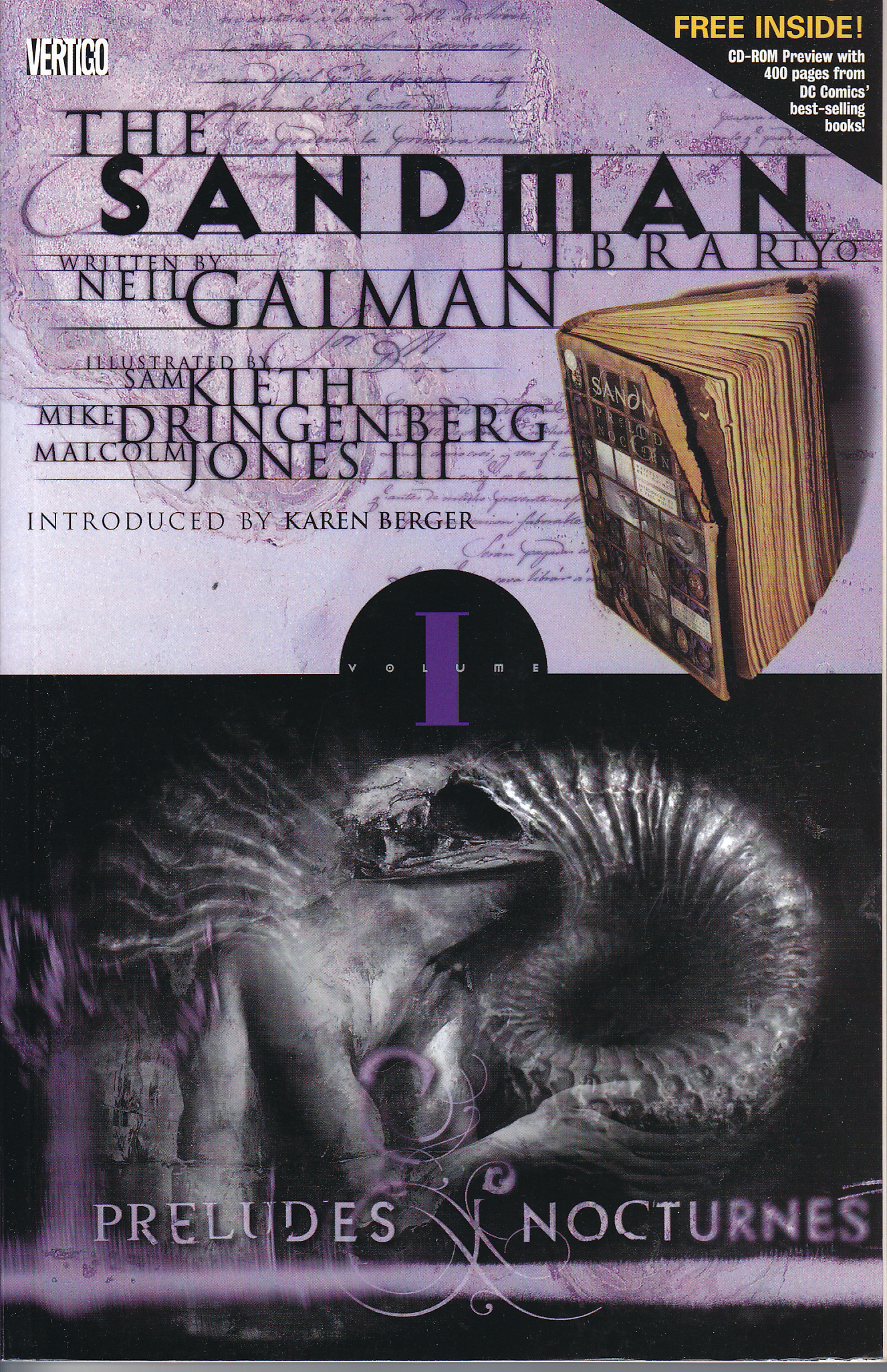 The first volume in the Sandman series, Preludes and Nocturnes tells of Dreams capture by Roderick Burgess, his eventual escape, and his recovery of his bag of sand, his mask, and his ruby.
The first volume in the Sandman series, Preludes and Nocturnes tells of Dreams capture by Roderick Burgess, his eventual escape, and his recovery of his bag of sand, his mask, and his ruby.
This collection especially makes me feel as if there's stuff I'm missing, not having grow up reading comics. John Constantine is a major character in the story "Dream a Little Dream of Me" and although I understand perfectly what is happening, I am pretty sure it would be more if I had read other comics about him.
"A Hope in Hell" I rather liked. And re-reading this makes me wonder if I might like the "Lucifer" series, because I find the character of Lucifer interesting. But I'm not certain I'll like it, and I also also very fond of Steven Brust's To Reign in Hell, and wonder if the series would pale in comparison. Oddly enough, the gruesomeness of the story doesn't bother me too much, despite the fact that it's set in Hell, and Hell is not a nice place.
However I skipped the story "24 Hours" because that I do find too disturbing and upsetting to read. It's good, but I'll stick with knowing what happened without having to read it again.
However my favorite story is the last, "The Sound of her Wings." It is as much a Death story as a Dream story--Death helps Dream get his head back together. I particularly liked the bit about Harry, no particular reasons except that I just find it satisfying--maybe because he didn't really die alone, because Death was there with him. It's a nice thought, that at the end, even if you're alone, you won't really be.
Death is before me today:
like the recovery of a sick man,
like going forth into a garden after sickness.
Death is before me today:
like the odor of myrrh,
like sitting under a sail in a good wind.
Death is before me today:
like the course of a stream;
like the return of a man from the war-galley to his house.
Death is before me today:
like the home that a man longs to see,
after years spent as a captive.
–From “Dialogue of a Misanthrope with His Soul” (ca 2000 BC)
Interestingly, I like reading the series again, because now I see characters that will return, like Nada. We get little glimpses of these characters, which makes them seem more familiar when we return to them later. The series is a nice change of pace from what I've been reading, and Neil Gamian's writing is always enjoyable.
Published by Vertigo
September 2005 | Rating: 7/10
August 2012 | Rating: 7/10
The Doll's House (1990) Neil Gaiman, Malcolm Jones III, Mike Dringenberg, Michael Zulli
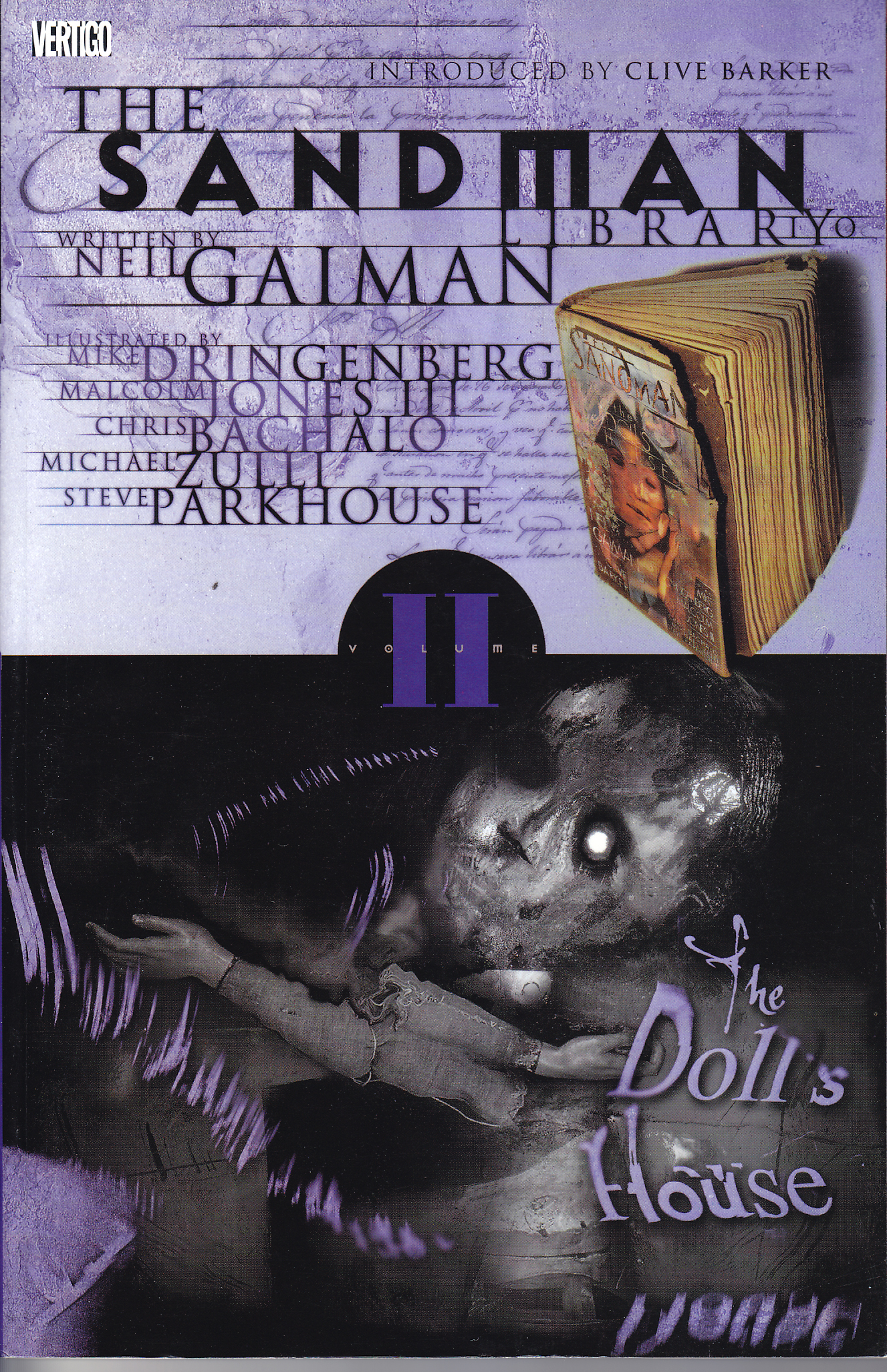 There is a vortex in the Dreaming, that Dream must control before it destroys the Dreaming. He must also find four of the major arcana that have wandered from the Dreaming: Brute and Glob, the Corinthian, and Fiddler’s Green. Meanwhile, Rose Walker searches for her younger brother, and discovered that she has a before unknown grandmother–Unity Kinkaid.
There is a vortex in the Dreaming, that Dream must control before it destroys the Dreaming. He must also find four of the major arcana that have wandered from the Dreaming: Brute and Glob, the Corinthian, and Fiddler’s Green. Meanwhile, Rose Walker searches for her younger brother, and discovered that she has a before unknown grandmother–Unity Kinkaid.
I particularly like two stories, neither of which was part of the current story line: "Men of Good Fortune" tells of Hob Gadling, who decides not to die, and "Tales in the Sand" is the story of Nada, who we saw very briefly when Dream went to Hell in Preludes and Nocturnes.
In both "Tales in the Sand" and "Playing House" Dream is a jerk to Nada and to Lyta, taking actions that will come back to haunt him later. I find that interesting, because I tended to forget that Dream could be so unpleasant to those who were not necessarily deserving of his wrath. Possibly because similar actions that he took in Preludes and Nocturnes were justified, and because he showed more mercy to John Dee than Dee deserved.
"Collectors" I mostly skipped this time. I know the Corinthian is scary. I don't really want to be reminded of it, especially since I'm a big wimp.
But mostly Dolls House sets the stage for the later events, and explains why things happen the way they do. Interestingly, I'd forgotten how many scary/gruesome stories were in this series. "The Collectors" "24 Hours" and I know there are more later on. It's odd that those parts weren't what stuck in my mind, despite the fact that such stories usually bother me, and linger for days or even weeks, in the back of mind.
Published by Vertigo
September 2005 | Rating: 7/10
August 2012 | Rating: 7/10
Dream Country (1990) Neil Gaiman, Malcolm Jones III, Colleen Doran, Kelley Jones, Charles Vess
 Dream Country is the third book in the Sandman series. In this collection of short stories, Dream is peripheral character for the most part, though in “Facade” Death appears instead.
Dream Country is the third book in the Sandman series. In this collection of short stories, Dream is peripheral character for the most part, though in “Facade” Death appears instead.
I'm particularly fond of "A Dream of a Thousand Cats." We have two cats, and I'm pretty sure that the older (and smarter) of the two thinks that he deserves to be ruling the world. I'll just have to hope that he doesn't find a thousand other cats to dream with him.
"A Midsummer Night's Dream" is also one that I really like. I'm not good at reading Shakespeare, but I like listening to it, and watching it, so I really enjoyed this story.
"Calliope" is another story I found disturbing to read, however it also lays down important bits for later in the series. It's disturbing to consider whether someone would really act like that, to their muse, if they thought it would help them.
"Facade" is a very interesting story, and not just because it's about Death instead of Dream. Would the CIA sacrifice (in a way) agents to an old God if it thought it gave them an advantage? Would they then leave those agents to waste away in solitude when they no longer needed them? And where did Rainie go, in the end?
Published by Vertigo
September 2005 | Rating: 7/10
August 2012 | Rating: 8/10
Season of Mists (1991) Neil Gaiman, Kelley Jones, Mike Dringenberg, P. Craig Russell
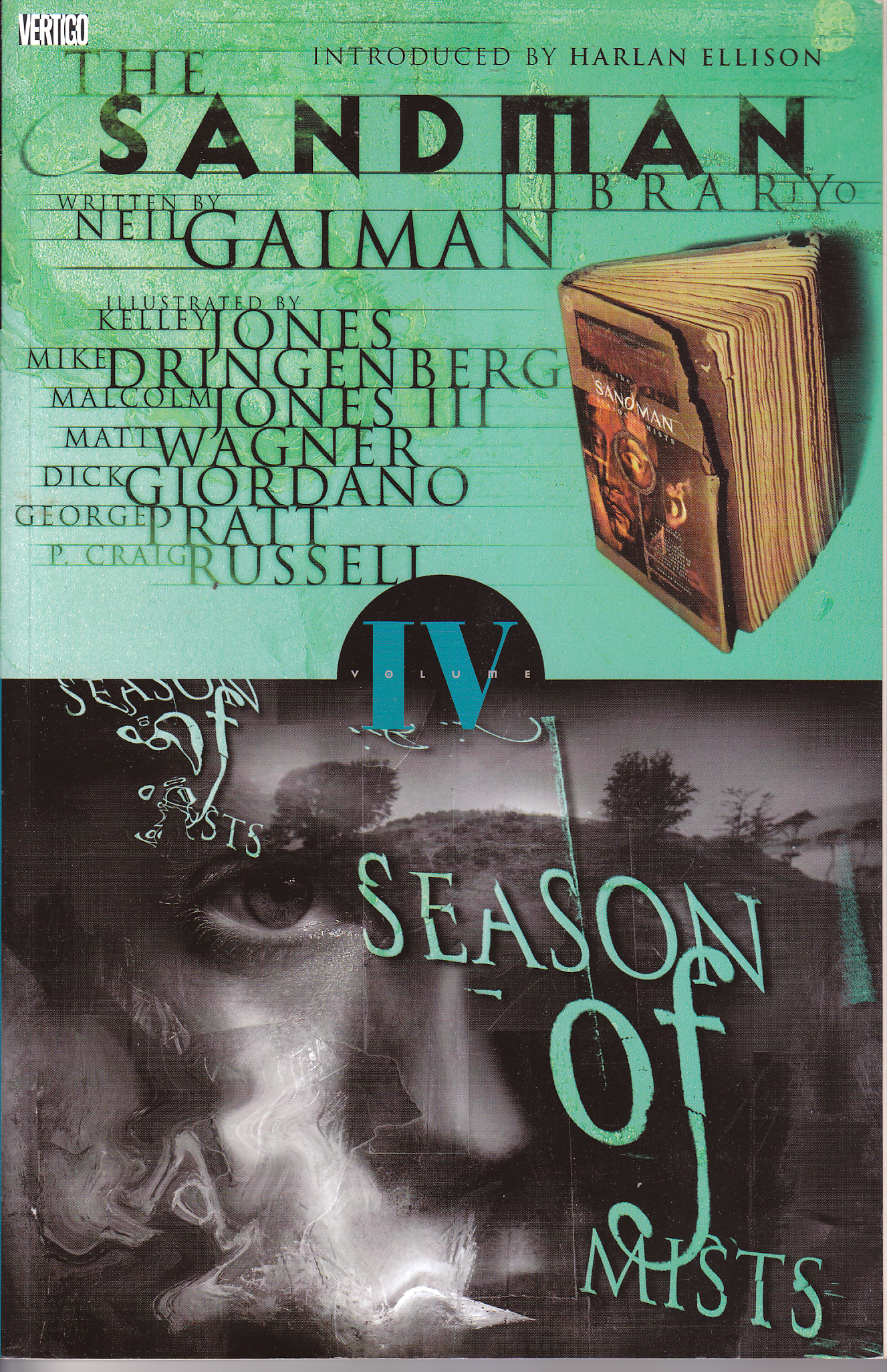 Season of Mists is the story of Dream’s journey to Hell to free Nada, after he is confronted by the fact that he unjustly sent her there ten thousand years before. All the stories in Seasons of Mists are part of a single tale, of Dream’s trip to Hell, and the aftermath of that trip.
Season of Mists is the story of Dream’s journey to Hell to free Nada, after he is confronted by the fact that he unjustly sent her there ten thousand years before. All the stories in Seasons of Mists are part of a single tale, of Dream’s trip to Hell, and the aftermath of that trip.
We first heard of Nada in Preludes and Nocturnes, and this book holds the conclusion of her tale. Dream is finally made to realize that he acted wrongly, that he treated her very badly, and that he had to make amends for his actions. I quite like that, since it bothered me that Nada had to suffer in Hell for doing the right thing, although in this Dream sets in motion more actions that will later come back to haunt him (so to speak).
My major complaint is that more than half the time I cannot figure out what Mazikeen is saying. Even if I try and sound it out, I still can't get it. It's not a huge problem here, as she doesn't say a lot that's important, but if I remember, it's very frustrating later on.
What I like best about Season of Mists is that Dream acts pretty justly throughout, which is a pleasant change from actions he has taken in the past. We also see Daniel, the son of Lyta Hall, for the first time. And Dream is still blind to the fact that she blames him for Hector's death, and the anger she carries because of this. It is this blindness that will cost him in the end.
I'm still fond of Nuala the faerie, and I still think she's more attractive without her glamour. But my favorite thing in Season of Mists is the introduction to the Library of Dreams, which has finally been rebuilt. The idea of reading books that were never written except in the dreams of their authors is a very appealing one. I mean, who would not want to read "The Conscience of Sherlock Holmes"?
It's the little bits like that, that make Sandman so appealing to me.
And don't miss the biographies in the back.
Published by Vertigo
September 2005 | Rating: 7/10
August 2012 | NR
A Game of You (1992) Neil Gaiman, Shawn MacManus, Colleen Doran, Bryan Talbot, George Pratt, Stan Woch, Dick Giordano
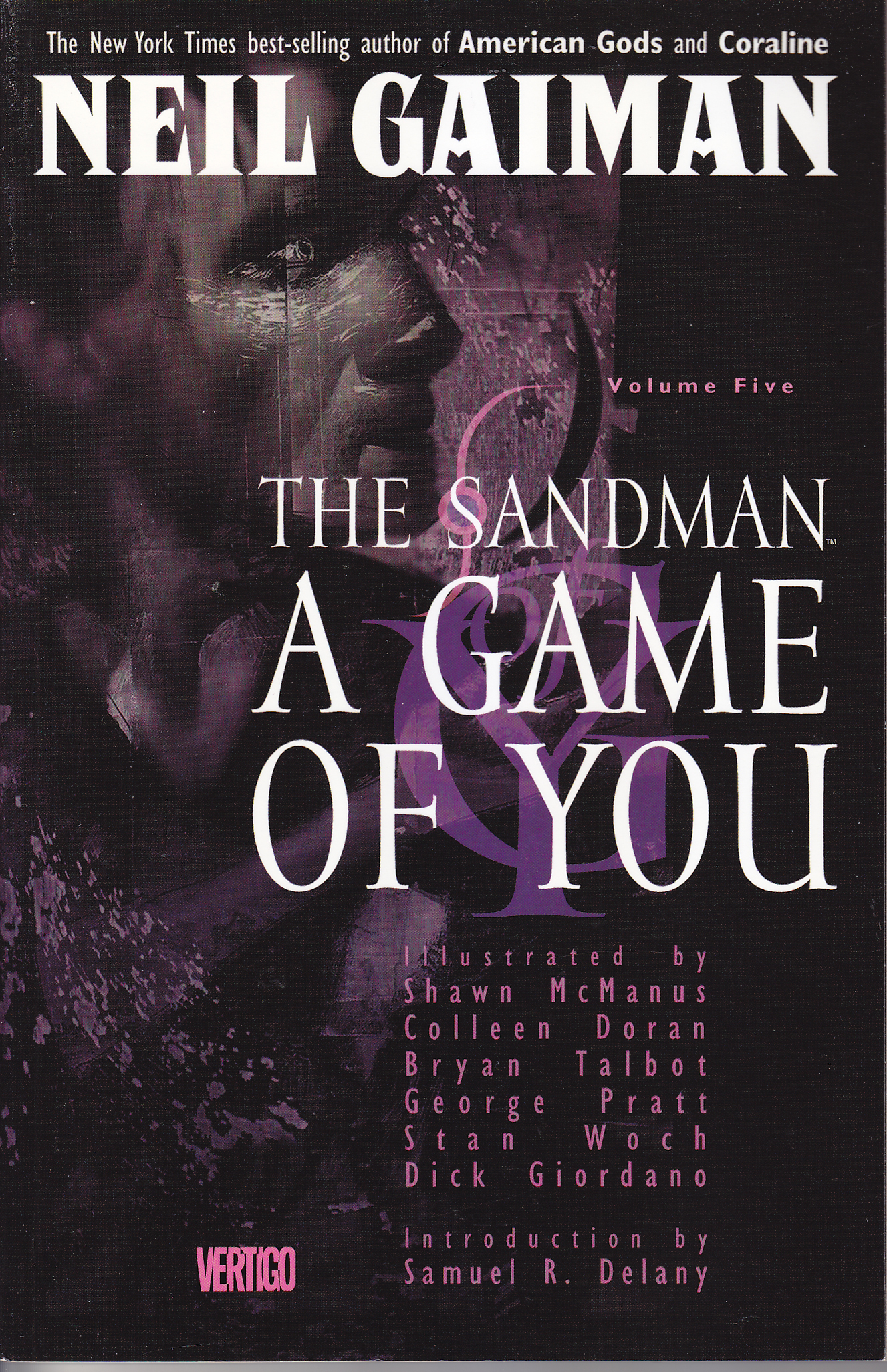 Barbie, who we first met in The Doll’s House, has moved to New York City after her break-up with Ken. She hasn’t dreamed for two years, when she was pulled into the dream vortex created by Rose Walker, but Barbie’s Dreamworld is not content to remain lost.
Barbie, who we first met in The Doll’s House, has moved to New York City after her break-up with Ken. She hasn’t dreamed for two years, when she was pulled into the dream vortex created by Rose Walker, but Barbie’s Dreamworld is not content to remain lost.
A Game of You is also where we are introduced to Foxglove and Hazel McNamara, who appear briefly in Death: The High Cost of Living, and are the center of Death: The Time of Your Life. I believe that I read all three of those out of order, beginning with The Time of Your Life and ending with A Game of You (because that was the order I got them.)
Like Season of Mists, A Game of You tells a single story, although multiple threads run through the story. Morpheus is almost incidental to the story, appearing only briefly. The first time I read this I was annoyed. I wanted to read more about Morpheus not about Barbie and these other characters. Reading it again later I don't mind, and I actually found the story quite compelling, the same as the characters. Except perhaps for Thessaly, who seemed to have lost much of her compassion the more she learned.
One bit that I particularly liked was where Dream remembers to tell Nuala that she did the right thing. It's a very small bit, but the way Dream walked away and then returned to tell her that was perfect. It also shows a very different Dream from the one who treats Lyta Hall so cruelly and casually--oblivious to her pain.
So despite the fact that Dream is only a minor character, I still quite like A Game of You.
Published by Vertigo
September 2005 | Rating: 8/10
August 2012 | NR
Fables & Reflections (1993) Neil Gaiman, Kent Williams, P Craig Russell, Jill Thompson, John Watkiss, Shawn McManus
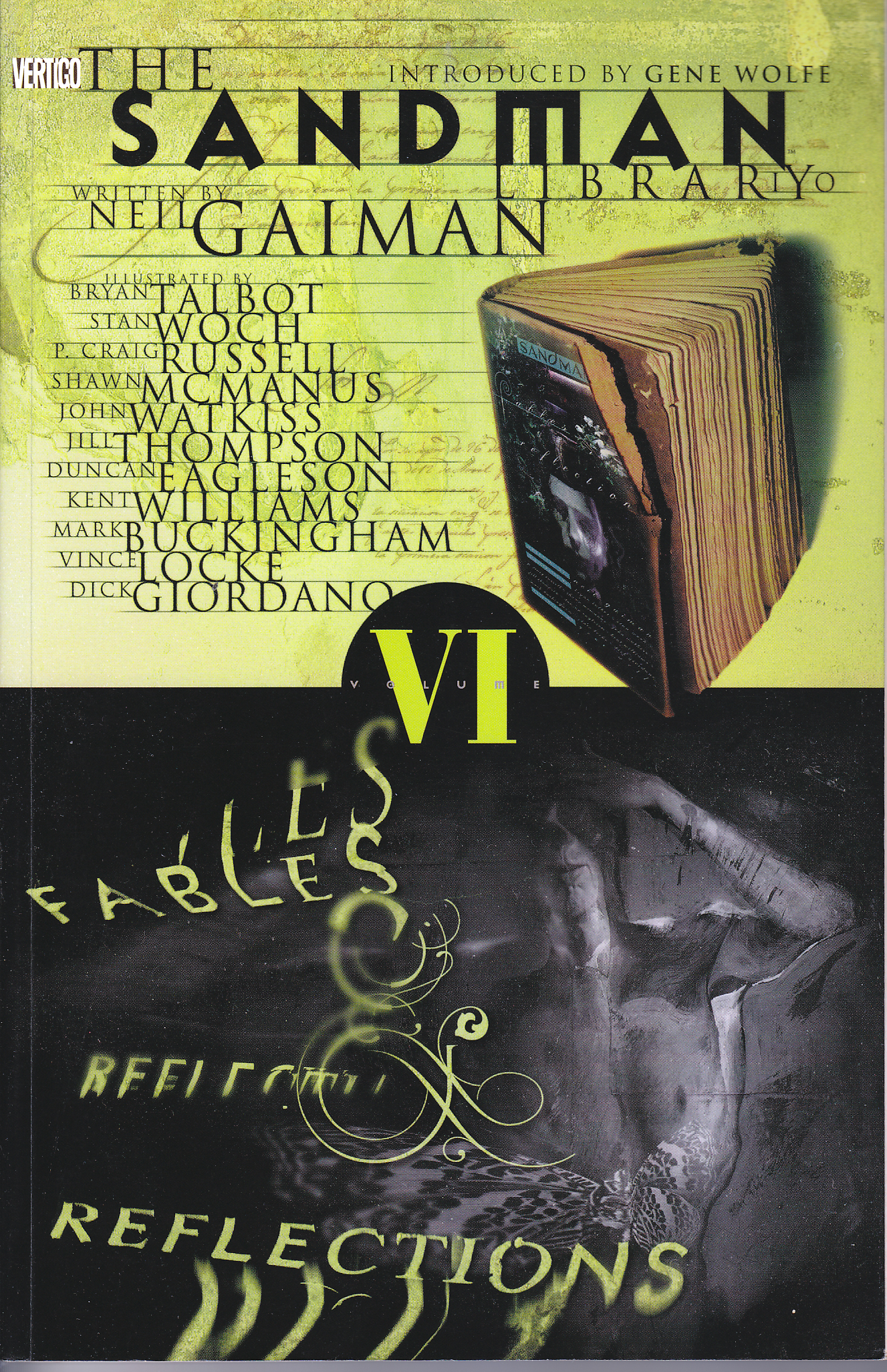 This may be my favorite Sandman collection. There are several different tales told, some in the past, some in the far past, and all excellent.
This may be my favorite Sandman collection. There are several different tales told, some in the past, some in the far past, and all excellent.
It starts with "Fear of Falling," a story of a man who is afraid to succeed. It's a short story and is the prologue of this book.
What follows is one of my favorite stories, "Three Septembers and a January," which tells of Joshua Norton, Emperor of the United States. Plus there is an appearance by Samuel Clemens. The story is fascinating in and of itself, even without intrigue by Despair and Delirium and Desire. (Oddly, the Despair in this story seems different somehow, from the despair of later stories. But it could just be me.)
A good portion of the book is dedicated to Orpheus, Dream's son. The first story, "Thermidor", tells of Johanna Constantine and her recovery of Orpheus' head from France during the French revolution, as well as the end of St Just and Robespierre. The second Orpheus story, "The Song of Orpheus," tells of his journey to hell to recover Eurydice.
But in this book it is the other stories that I like so well. I particularly like "The Hunt." A grandfather tells her a story of the past to his granddaughter, who may love him, but who is also a teenager. I particularly love the scene where she has interrupted him one too many times, "Listen, blood of my blood. Although I'm a hard man to anger, and I love you deeply, if you interrupt me again so help me I'll rip your throat out with my teeth." "Sorry Grandfather." It reminds me very much of "The Princess Bride" where the sick boy keeps interrupting the story. ("Yes. You're very smart. now shut up.") I also love the art in this story. The way the boy is drawn I particularly like, although I couldn't tell you why. Also, Baba Yaga and her hut on chicken legs. Yay!
The story "August" I like, but find it terribly sad.
"A Parliament of Rooks" sees Daniel out on his own in the Realm of Dreams, although the heart of the story is the stories told by Cain, Abel, and Eve. I particularly like the way the art changes in Abel's story, to match the story he is telling Daniel--as well as the way it switches back to what is really happening.
And then there is "Ramadan," which is just beautiful all the way around. I love the story and I love the artwork. This is one of the few tales where I was really drawn into the artwork (the other is Dream Hunters)
It's not one thing about this book, it's everything really. But at the center are the stories. And I particularly love the stories in Fables & Reflections.
Published by Vertigo
September 2005 | Rating: 9/10
August 2012 | NR
Brief Lives (1994) Neil Gaiman, Jill Thompson, Vince Locke
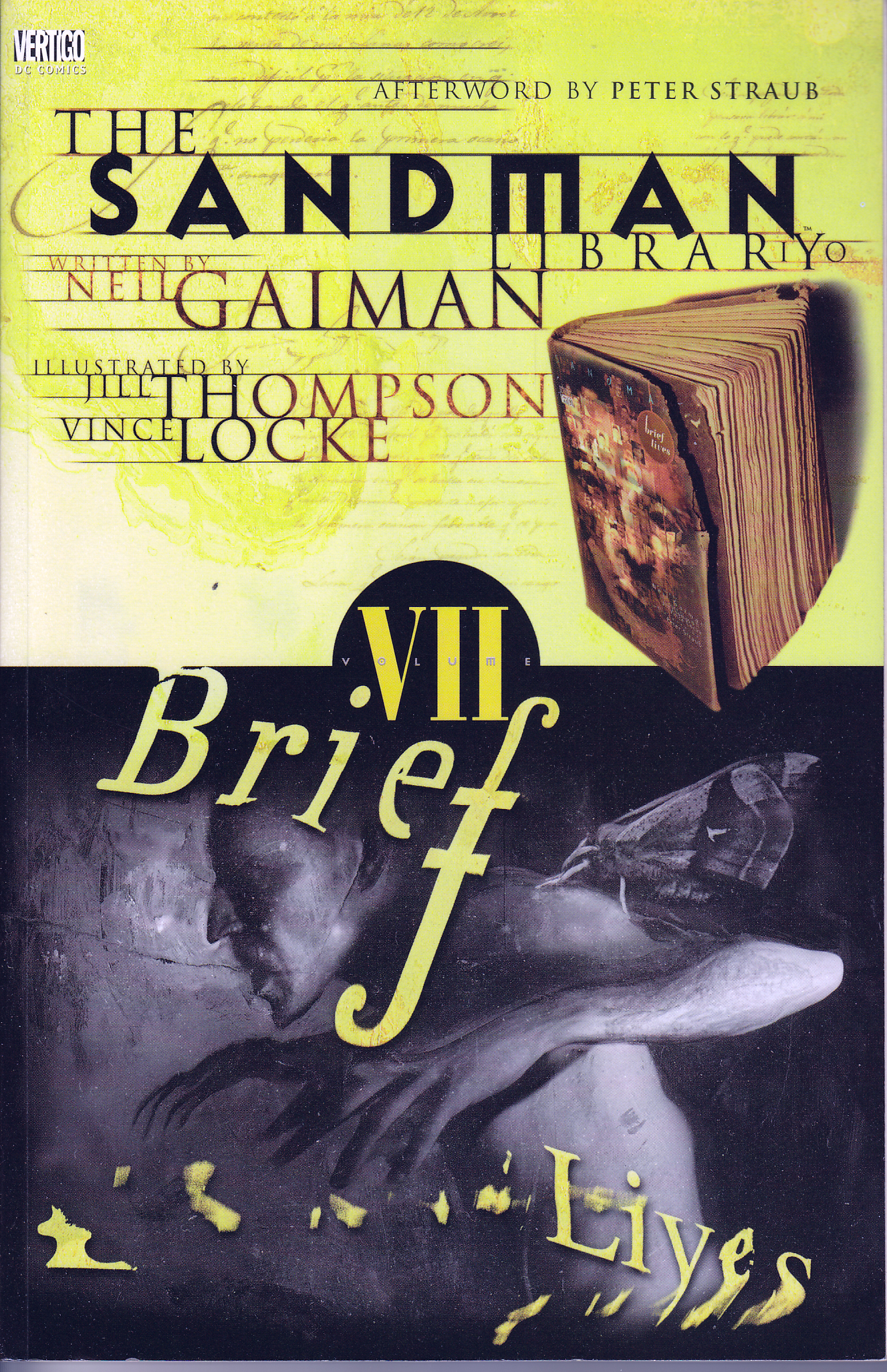 In Brief Lives Delirium decides that she wants to search for her brother Destruction, who abandoned his job 300 years earlier. She goes first to Desire and Despair, both of whom tell her to abandon her idea of finding Destruction. After all, he had reasons why he left, and if he wanted to be found then he would have returned to them on his own.
In Brief Lives Delirium decides that she wants to search for her brother Destruction, who abandoned his job 300 years earlier. She goes first to Desire and Despair, both of whom tell her to abandon her idea of finding Destruction. After all, he had reasons why he left, and if he wanted to be found then he would have returned to them on his own.
But Delirium insists that she wants to find them, and goes next to Dream who, dwelling on his recently ended relationship decided that change will do him good, and agrees to join Delirium on her quest, unaware of where this decision will lead, and of the consequences it will have.
Earlier stories introduced us to Hob Gadling and Mad Hettie, who have decided they don't want to die. Here we learn that there are others who have decided the same--some who have lived for thousands of years.
This book also introduces one of my favorite minor characters in Sandman--Barnabas.
This is a very important book in the story arc. It's not necessarily one of my favorite books, but you have to read Brief Lives to understand what happens later.
Published by Vertigo
October 2005 | Rating: 7/10
August 2012 | NR
World's End (1994) Neil Gaiman, Bryan Talbot, Michael Zulli, Michael Allred, John Watkiss
This is my second favorite book in the Sandman series. Like my favorite, Fables and Reflections, it's a collection of short stories. A disparate group of people are caught in storms and end up at World's End: A Free House. As they all wait for the storm to abate, the sit, and eat and drink, and tell stories, and World's End tells some of these stories.
The first time I read this, I was in denial about the last story, and what it meant. In retrospect, I can see that perhaps Neil Gaiman was trying to prepare us for the events collected in The Kindly Ones, and had been doing so throughout the series. Didn't work for me, though. I can be pretty stubborn and oblivious when I want to be.
Although I like all of the tales in World's End, I think that "Cerements" is my favorite. I'd never considered a Necropolis as a place where the inhabitants prepared the dead, and the idea fascinates me.
I also particularly liked "Hob's Leviathan." I like the character of Hob, and enjoy it when he appears from time to time. He isn't the main character in the story, but we get to see how he had managed to live for so many years, while retaining a place in respectable society. One knows that making a new life can be done--you hear stories all the time--but how much easier must it have been before the modern era. How much harder will it be with the development of biometric identification?
The story "A Tale of Two Cities" is a strange and fascinating one. I've never lived in a big city--only visited some for short times--so the idea of a city as a living entity is a strange one to me, although not an unreasonable one. The artwork in the story is also very different. It's stark, and the layout is quite different--even I noticed the changes.
Interestingly, again, Dream is only a minor character in these story, which I found frustrating the first time I read this story, as I wanted more about Dream, however the second time around I didn't mind at all. Knowing that Dream is only a minor character, I was able to enjoy the stories as they are, and they really are wonderful stories.
Although World's End is not necessarily integral to the overall Sandman story arc, it is still one of my favorites. But then I love short stories, so that may have a great deal to do with why I like this book so well.
Published by Vertigo
October 2005 | Rating: 9/10
August 2012 | NR
The Kindly Ones (1996) Neil Gaiman, Marc Hempel, Richard Case, D'Israeli, Teddy Kristiansen, Glyn Dillon, Charles Vess, Dean Ormstrom, Kevin Nowlan
 This is my least favorite book in the Sandman series. Part of it has to do with the fact that it’s a sad storyline. Normally in a book you have the good and bad parts together, however in the Sandman, there were eight books leading up to The Kindly Ones, so it’s pretty much all heartbreak within.
This is my least favorite book in the Sandman series. Part of it has to do with the fact that it’s a sad storyline. Normally in a book you have the good and bad parts together, however in the Sandman, there were eight books leading up to The Kindly Ones, so it’s pretty much all heartbreak within.
The other reason, however, is that I really dislike much of the artwork in this collection. It's angular and strange and no one quite looks like themselves. I kept having to go stop and go back and try and figure out who people are, because they just don't look the same as they have in other stories. Everything is harsh and hard and makes the story even harder to read than it already is.
As far as the story, as I said, it's good, but sad. There's nothing here to soften the blow or to make things easier. In retrospect, you should have seen it coming, but that doesn't mean you did.
If you've been reading along then you, of course, must read this book. It's the conclusion of the story. The Wake, Book 10, is just the end of the story tidying up--a necessary tiding up--but The Kindly Ones is where everything happens. You close the book knowing that this is the end. There may be another book--a small one--to follow, but this, this book contains the end.
Published by Vertigo
October 2005 | Rating: 7/10
August 2012 | NR
The Wake (1996) Neil Gaiman, Michael Zulli, Jon J. Muth, Charles Vess
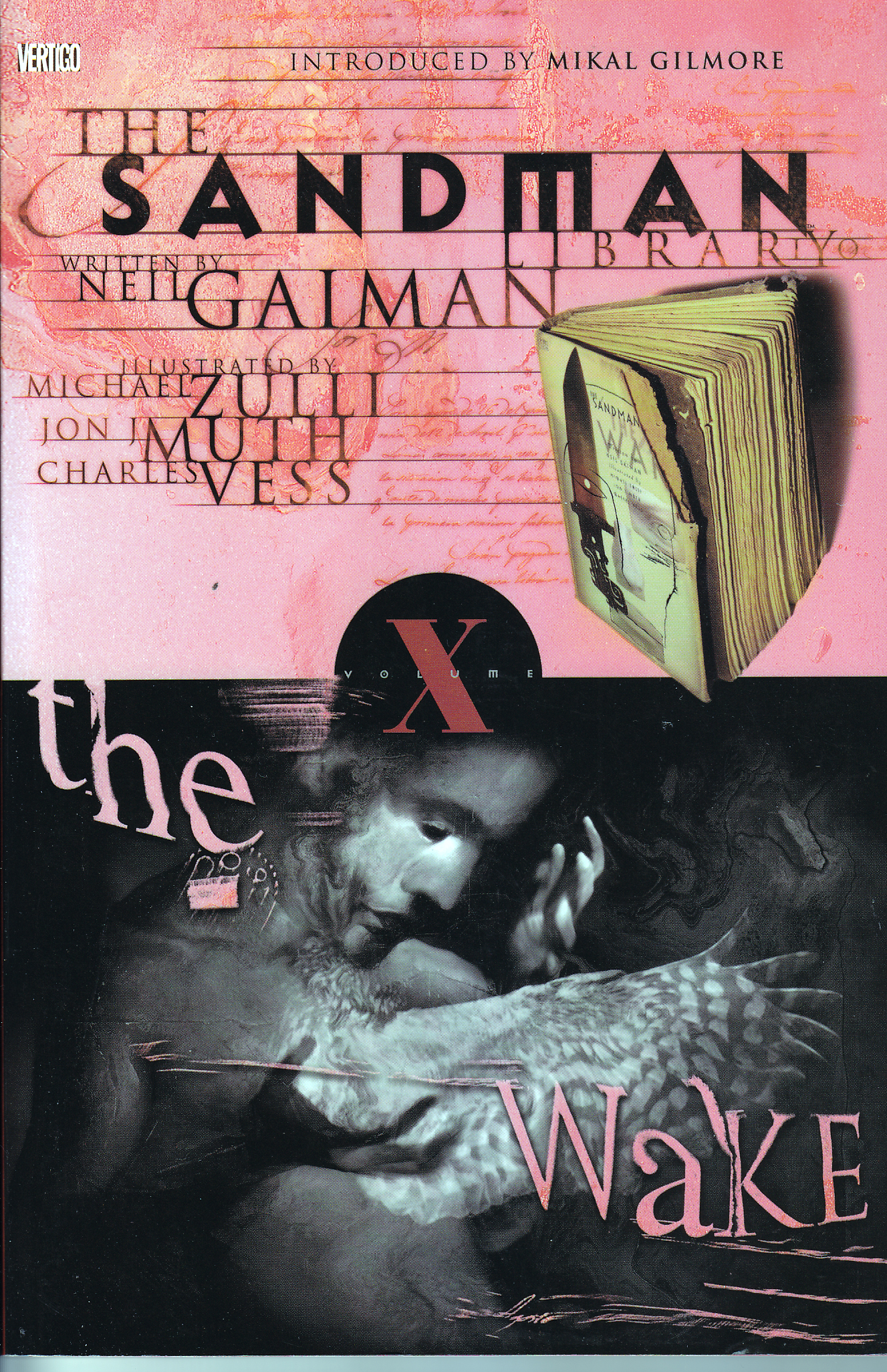 The final book in The Sandman collection, volume 10, The Wake tells of the funeral of Morpheus, Dream of the Endless, and of how Dream rebuilds his realm, and meets the rest of his family.
The final book in The Sandman collection, volume 10, The Wake tells of the funeral of Morpheus, Dream of the Endless, and of how Dream rebuilds his realm, and meets the rest of his family.
I particularly like seeing how Matthew comes to terms with Dream's death and his return. Perhaps because he is younger than others in the Dreaming, his reactions are different, his feelings more intense, and the mirror what I as the reader am feeling at the time. Lucien and Eve have been around for millennia. They have come to accept things in the Dreaming that Matthew still questions.
Regardless, it's a lovely touch.
The remaining three stories are short tales. "Sunday Mourning" is about Hob, his adjustment to the death of Dream, and his continuing to come to terms with his past.
"Exiles" is another of my favorite stories. An old man and a kitten cross the desert, and twice meet with Dream. I love the art and the layout and the story. It all comes together perfectly for me, despite the fact, or perhaps because, it is story far more than it is dialogue, as the old men composes in his head, the letter he will wrote to is friend.
The last story, "The Tempest" finishes with Shakespeare as he concludes his deal with Dream. Although "The Tempest" provides us with a final insight into Dream, and why things happened the way they did, I think I would have preferred had the closed the series with "Exiles."
If nothing else, reading The Wake through to the end gets me past the weepy feeling I get reading The Kindly Ones. It concludes everything, and lets you know that the stories will continue, even if we won't be reading them.
Though of course we will, since I've already read, Endless Nights and The Dream Hunters, so I know there are at least two more stories to come. Although probably no more.
Published by Vertigo
October 2005 | Rating: 8/10
August 2012 | NR
Sandman: Endless Nights (2003) Neil Gaiman, Frank Quietly, Glenn Fabry, P. Craig Russell, Milo Manara, Bill Sienkiewicz, Miguelanxo Prado, Barron Storey
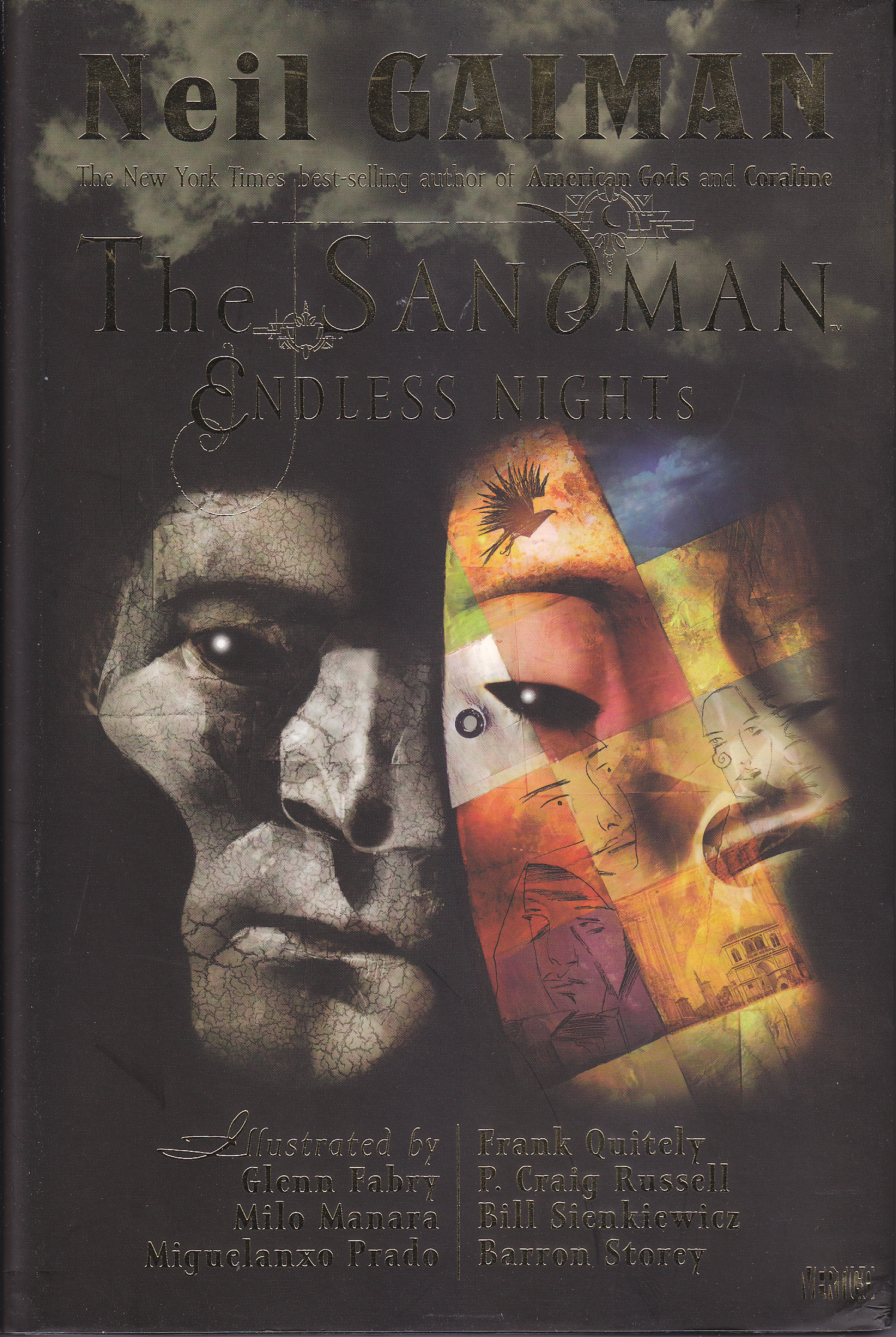 Endless Nights is a collection of tales, one about each of the Endless. I've read that some people didn't like Endless Nights because it was seven different short stories instead of one cohesive story. Well, I love short stories, so I thought the format was perfect.
Endless Nights is a collection of tales, one about each of the Endless. I've read that some people didn't like Endless Nights because it was seven different short stories instead of one cohesive story. Well, I love short stories, so I thought the format was perfect.
To be honest, what I mostly wanted was another story about dream, and a story about death, which is I suppose selfish of me, for the other Endless have just as much to offer as Dream and Death, but those are the two that fascinate me the most.
The first tale was of Death, and her patience. In the introduction he said the story was written following September 11th. I quite liked the soldier who was tangled up in the story.
I'm not fond of the character of Desire at all, but then Desire strikes me as a bit of a bully, and I've never liked bullies. That made me view the story of Desire with a bit of trepidation, and, unlike Despair, who seemed only tangential to her story, I was somewhat glad the Desire was not the main character of her story. But then I've never claimed to be consistent. As it turned out, I liked the story about Desire, especially as it related to Despair. I think that Desire and Despair have been called twins, opposite sides of the same coin I suppose, and I think this story was a description of that.
The story about Dream was rather sad, yet a further explanation of why Dream, is the way he is. It was also interesting to see Delight, the youngest, as a child, which is really how she is throughout the series. I also really liked the idea of the suns and planets getting together for a conference.
I had difficulty with Despair, partially because it was a poem as much as a story, and partially because the artwork was fractured. It was perfect for Despair, but I had a hard time following it, but that is probably me, since I also have trouble reading Shakespeare, but enjoy the plays and hearing the stories read. The thing that I found must frustrating about the story, is that although it was a story about how Despair affects others, we learned little about Despair herself, which I thought was too bad, because it seems that Despair should be a deep character. I wanted to know more about her, instead of more about her work.
The story about Delirium was interesting, mostly because she played so small a part in it, and there was so much that was left unsaid. What happened to her to send her inside? Did the mission to help her make all the people who helped better, or just the one woman. And I still want to know what happened to change Delight to Delirium.
Destruction was an interesting tale, partially because it was good to see that Destruction was looking after Delirium and partially because of the idea of excavating the future. Was it the presence of Destruction and Delirium together that did that? Was it just one of those things that happened? Had it happened in the past with the same results?
Destiny--I like the artwork, and it was a good ending to the book. Of course I read the entire book before bed, so perhaps that was why I liked Destiny so much. It was calm and relaxing and seemed to sum things up.
As a whole, the book as different from the other Sandman tales, not just because all the stories were not about Dream, but because the book had a different feel to it. Probably due to the time that elapsed between the last Sandman comic and this book, but perhaps also because of the difference between Dream and his siblings. Regardless, I loved it and recommend it.
Published by Vertigo
September 2005 |
The Sandman: The Dream Hunters (1999) Neil Gaiman, Yoshitaka Amano
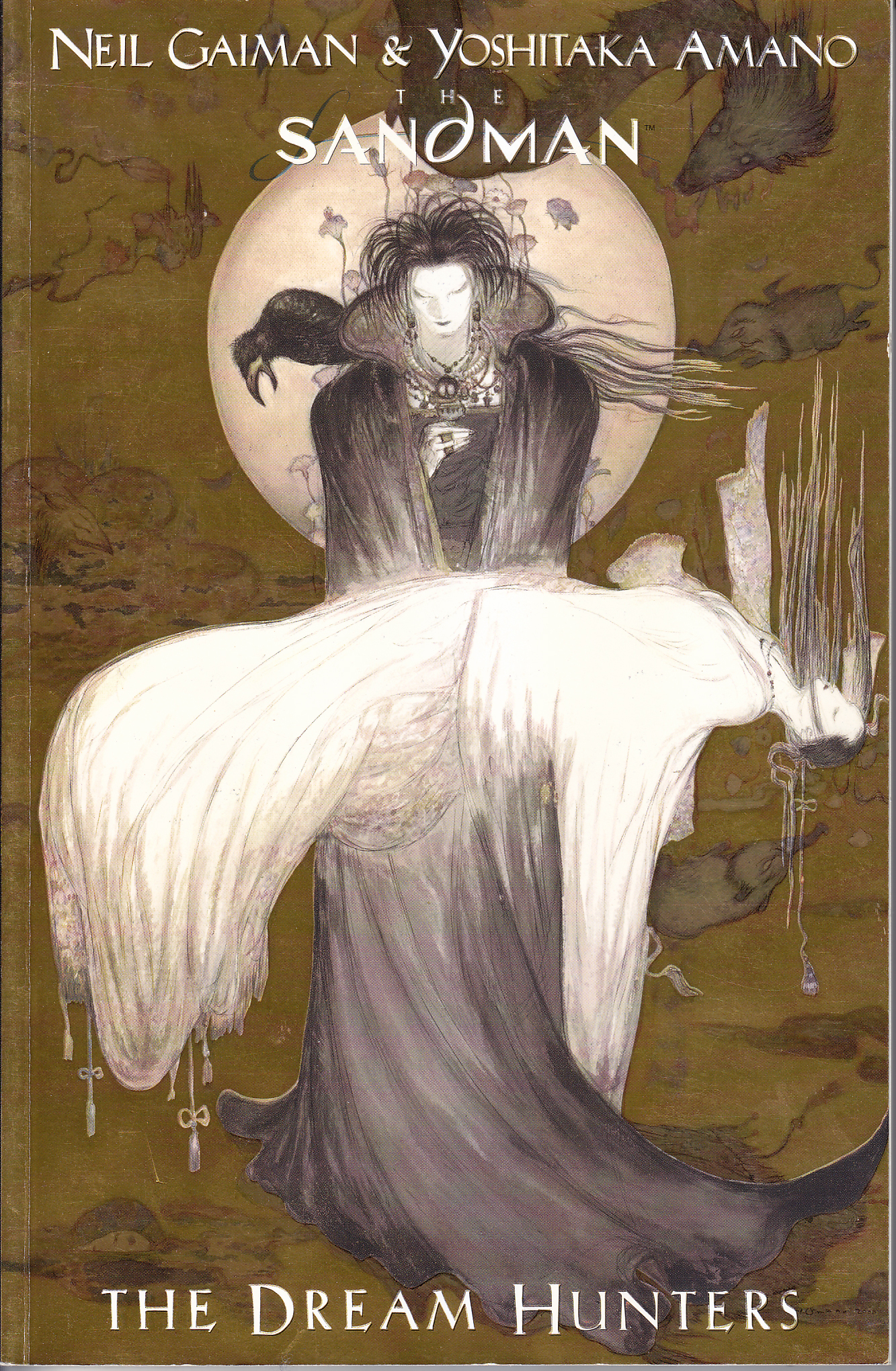 The Dream Hunters is my favorite Sandman story. It's not a comic proper, but is instead an illustrated story.
The Dream Hunters is my favorite Sandman story. It's not a comic proper, but is instead an illustrated story.
And the illustrations are gorgeous. I tend to do little more than glance at illustrations, but the art here is impossible to ignore.
Based on a Japanese folk-tale "The Fox, the Monk, and the Mikado of All Night's Dreaming," Dream Hunters tells of a Monk who tends a Temple at the top of a mountain, and the Fox who wagers with a Badger and attempts to trick him away from his Temple and Home.
Familiar Sandman characters appear, but not in their usual guises, the Kindly Ones, Cain and Abel, the Raven (although this raven is not Matthew, but an earlier raven). I very much like Yoshitaka Amano's idea of these characters. In the Sandman series, we saw that Dream and his realm change in response to the expectations of those who are perceiving him, and so the changes here are not disconcerting, but are expected, for these characters would not see the Goth like Dream of Preludes and Nocturnes, but would instead see a Dream of their own time and place and kind.
But as with all of Neil Gaiman's stories, it is the writing that I adore the most.
Then (the monk) made his evening devotions, although he made them with slightly less enthusiasm than usual. It is one thing to pray; it is another to pray to entities who might not only be listening, but who will search you out on the road and beat you across the head with sticks if you say something that offends them.
And I love the fox. It seems to me as if he has gotten the Fox just right.
A fly alighted on the fox's forehead, and walked, slowly, down to the tip of her muzzle. She resisted the urge to snap at it; instead she just lay there, eyes unfocused and blank, a dead thing.
For only a trickster creature, a wild creature of strong will, could achieve such stillness.
The writing on its own is fantastic and the artwork is gorgeous. Combined they create a book that is one of my favorites.
If you are not familiar with Sandman and would like an introduction to the character, this would be a good place to start. If you are a fan of Sandman, then you have probably already read this story, but if you have not, this is definitely a book you do not want to miss. It is certainly one that I enjoyed reading again and again.
Published by Vertigo
October 2005 | Rating: 10/10
March 2008 | NR
